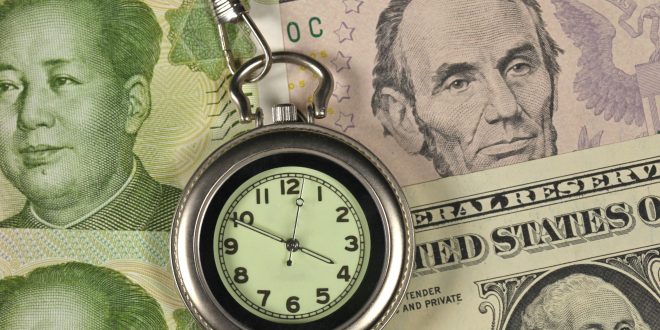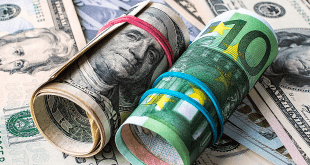The third week of May was highlighted by the release of last month’s Federal Reserve meeting minutes, which surprised the markets by showing that some members of the Federal Open Market Committee (FOMC) believe that if the economic recovery in the United States continues to gather pace, it might be appropriate in the coming months to begin discussing tapering asset purchases.
Recent remarks by Fed officials, led by Chair Jerome Powell, indicated that before raising interest rates, the U.S. central bank will begin by reducing the size of its massive bond-buying from the current level of $120 billion a month. In addition, the Fed has vowed to notify the markets before making such a move to avoid any disturbance.
The Fed is showing more signs that it is moving forward with efforts to establish its own official digital currency, as it announced on Thursday that it plans to publish a research paper in the summer that explores the prospects of issuing a digital currency, or a central bank digital currency (CBDC).
“The effective functioning of our economy requires that people have faith and confidence not only in the dollar, but also in the payment networks, banks, and other payment service providers that allow money to flow on a daily basis,” the Fed Chair, Jerome Powell, said.
According to the Chairman, the Fed is carefully monitoring and adapting to the developments in the digital currencies and payments domain. “Our focus is on ensuring a safe and efficient payment system that provides broad benefits to American households and businesses while also embracing innovation,” Powell added, commenting on the announcement. “Technological advances also offer new possibilities to central banks, including the Fed. While various structures and technologies might be used, a CBDC could be designed for use by the general public,” he added.
Powell also revealed that the Fed is committed to hearing a wide range of voices on this important issue before making any decision on whether and how to move forward, “taking account of the broader risks and opportunities it could offer. The paper represents the beginning of what will be a thoughtful and deliberative process.”
Last October, Powell said that it is more important to get it right than to be first, when discussing issuing a digital currency by the central bank, explaining getting it right by not only looking at the potential benefits of a digital currency, but also the potential risks. Then in February, he went on to tell the House of Representatives that the Fed might need congressional approval before issuing a digital Dollar.
On another note, U.S. home sales continued to decline during April for the third consecutive month, according to the National Association of Realtors (NAR). Existing home sales fell by 2.7% to a seasonally adjusted annual rate of 5.85 million units last month. Meanwhile, home sales rose by 33.9% on an annual basis, which is mainly due to the huge drop in sales in April 2020, amid the onset of the first wave of the coronavirus pandemic.
As for the U.S. housing starts, a monthly decline of 9.5% was recorded in April, following March’s sharp increase of 19.8%, a reading that was revised upwards from 19.4%. Building Permits, which rose by 1.7% in March, increased by 0.3% last month.
Another important indicator was the applications for new claims for U.S. unemployment benefits declined below 500,000 in the previous week, with initial claims for state unemployment benefits decreasing by 34,000 to a seasonally adjusted 444,000 for the week ended May 15, according to the U.S. Department of Labor.
This marked the lowest level for the initial jobless claims since the beginning of the global outbreak of the coronavirus pandemic in March 2020, and the second consecutive week maintaining its level below the 500,000 mark.
Nevertheless, jobless claims remain above the 200,000-250,000 average range, which is viewed by economists as a sign of a healthy labor market, and continuing jobless claims rose by 111,000 to 3.751 million during the week ended May 8.
In addition, factory activity in the United States expanded in May, supported by robust local demand, as the flash U.S. manufacturing purchasing managers’ index (PMI) rose to 61.5 in the first half of May from 60.5 in April, according to IHS Markit, reaching its highest reading since October 2009.
The IHS Markit U.S. flash services sector PMI surged to 70.1, its highest reading on record since October 2009, from 64.7 in the previous month. The flash composite PMI output index increased to 68.1 from 63.5 in April.
Next week, U.S. President Joe Biden is set to reveal his first detailed budget proposal on May 28, the White House announced. The new budget will be for the upcoming fiscal year starting next October.
Biden took office last January, making this the first fiscal year entirely falling within his term.
In Europe, data by Eurostat showed that the inflation rate in the Eurozone accelerated in April, due to a sharp increase in energy and service costs.
The consumer price index (CPI) in the bloc’s 19 countries rose 0.6% on a monthly basis, and recorded an annual increase of 1.6%, up from 1.3% annually in March.
Dollar
The U.S. Dollar (USD) fluctuated over the week, but releasing the Fed’s meeting minutes on Wednesday was a turning point for the greenback, which erased most of its gains one day later, before rebounding again in the last session of the week.
The Dollar Index (DXY), which measures the Dollar’s performance against a basket of six major international currencies, finished Friday higher but down for the week by about 0.30%.
It is worth noting that the Office of the Comptroller of the Currency (OCC), an independent bureau within the United States Department of the Treasury, has warned against overconfidence in the banking sector, calling for caution, pointing to the recent Archegos Capital fund crisis, which negatively impacted a number of leading banks.
Euro
Business activity in the Eurozone expanded during May, growing by the best pace in more than three years. In addition, the Eurozone IHS Markit’s Composite Purchasing Managers’ Index (PMI) rose to a flash reading of 56.9 in May from 53.8 in April, registering its best level since February 2018.
Economic indicators showed an improvement in France’s business activity and the German services sector, with readings exceeding expectations in May.
Accordingly, the positive economic data provided support for the Euro (EUR). For the week, the EUR/USD pair recorded a rise of about 0.34%.
The European Central Bank (ECB) President, Christine Lagarde, recently said that recovery remains challenged by uncertainty despite massive support to the economy.
The ECB’s Financial Stability Review showed that the low interest rates are adding to the challenge of zombie companies, noting that recovery will reveal the extent of the problem. According to the report, risks of financial stability are increasing in Europe, especially with the challenges of the coronavirus pandemic. It also added that the number of bankruptcies fell by 18% in 2020 across the European Union (EU), due to the increased government support to businesses.
Sterling
The British Pound (GBP) showed another positive weekly performance against the declining USD, especially as easing lockdown measures and the sharp decline in the number of new coronavirus cases provided support for recovery hopes, signaled by the recent economic data.
Industrial orders in the United Kingdom (UK) rose by the fastest pace since December 2017, with balance of industrial orders increased to 17 in May from -8 in April, according to the Confederation of British Industry (CBI).
During the past three months, the total growth in industrial output was the largest since December 2018.
As for the Consumer Prices Index (CPI), an annual increase of 1.5% was recorded in April, when compared to a 0.7% rise in March, beating market expectations of a 1.4% rise.
The GBP/USD pair rose by about 0.38% for the week, closing at 1.4150, after ending two separate sessions as high as 1.4190.
Gold
Gold prices ended a six-session rising streak, which was the longest since the end of July 2020, to limit its weekly rise to about 2.1%, as the yellow metal futures for June delivery ended the week at $1,876.70 per ounce.
Gold futures remain near their highest level since the first week of the year.
This marked the third consecutive weekly rise for gold’s most active contract.
Oil
Oil prices finished the week in losses, which resulted mainly from concerns that progress in the talks between the United States and Iran to revive the nuclear deal might lead to lifting sanctions on Tehran, thus allowing more output and disrupting the market, especially in a time in which major producers are gradually, and carefully, easing production cuts.
Nonetheless, losses were limited by a late increase supported by possible supply disruptions in North American due to a subtropical storm forming near the Gulf of Mexico.
Brent crude futures for July delivery finished the week at $66.44 per barrel and registered a weekly decline of 3.3%.
The West Texas Intermediate (WTI) crude futures for July delivery lost 2.7% for the week, as it closed at $63.58 per barrel.
European Stocks
European stocks were supported by positive economic data that took the attention away from inflation fears.
The STOXX Europe 600 index finished higher by 0.61% on Friday, with the auto sector leading the gains and adding 1%. Accordingly, the pan-European index managed to finish the week with small gains, following a series of fluctuations.
Wall Street
The New York Stock Exchange (NYSE) showed a mixed performance over the course of the week, amid a mix of inflation fears and recovery hopes.
The Dow Jones Industrial Average and the S&P 500 registered their second consecutive weekly declines, while the Nasdaq Composite Index managed to register its first weekly gains in a five-week period.
Cryptocurrencies
Bitcoin maintained a negative trend this week, while it was barely recovering from being neglected by Tesla that announced that it will no longer accept the cryptocurrency as a payment method, it was faced by strong measurements by China, in a bid to face financial risks.
Tesla’s decision continues to leave its toll on Bitcoin, as the electric vehicles manufacturer is a major institutional investor in the digital currency with about $1.5 billion recently pumped into Bitcoin. Moreover, the billionaire CEO of Tesla, Elon Musk, is a major advocate of crypto.
The Chinese Vice Premier, Liu He, announced plans by the government to crack down on Bitcoin’s mining and trading activities, as the Chinese Financial Stability and Development Committee revealed that measurements against the largest cryptocurrency in the world come as part of larger efforts to curb financial risks.
Bitcoin lost more than 30% for the week, while Ethereum and Dogecoin lost 20% each.
 Noor Trends News, Technical Analysis, Educational Tools and Recommendations
Noor Trends News, Technical Analysis, Educational Tools and Recommendations





